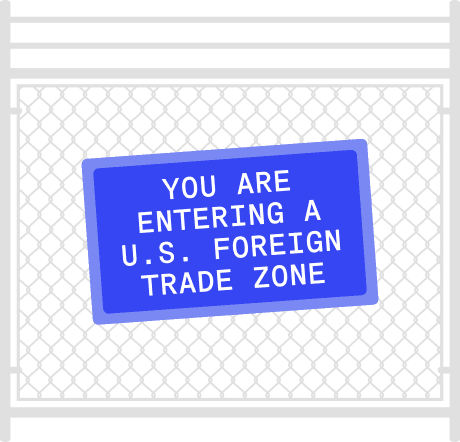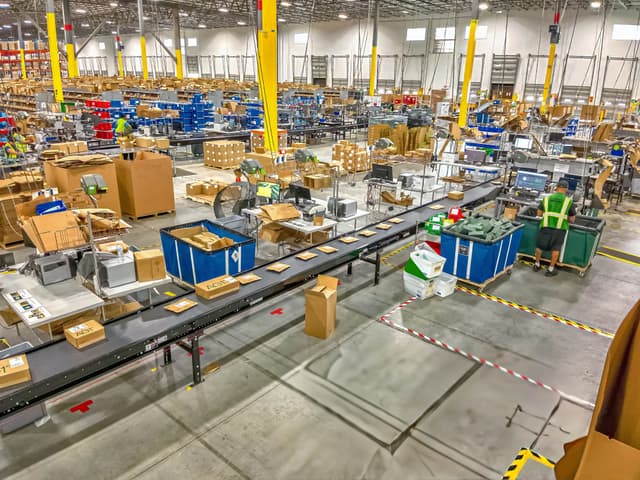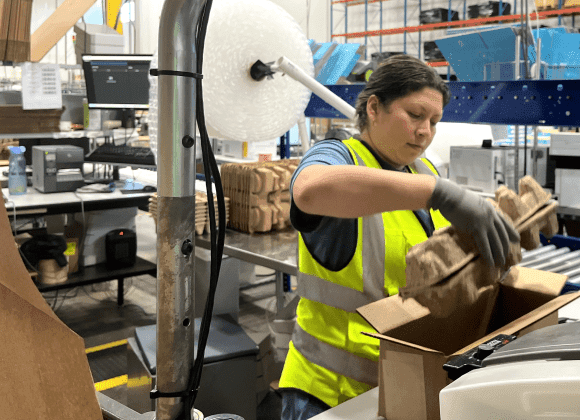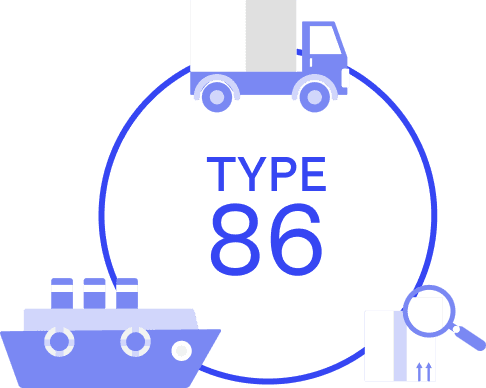4. Tactical Strategies to Mitigate Margin Loss
After immediate triage, brands need to make changes to their fulfillment strategy to offset the cost increases:
Shift to U.S.-Based 3PLs or Domestic Warehousing
One of the most effective long-term mitigations is to bring your fulfillment stateside. If you currently ship each order from overseas, pivot to importing in bulk and stocking inventory in a U.S. warehouse. By leveraging a unified system like Stord's OMS, brands can seamlessly manage this new multi-node inventory. After clearing customs, you can fulfill orders from your domestic stock via normal ground shipping, which will be faster and more predictable.

A solution like Stord Parcel can automatically select the most cost-effective ground shipping option for each order, further optimizing the domestic fulfillment process. This approach trades some upfront cost and complexity for lower variable costs per order. For example, a brand might air freight a week’s worth of orders shipped from overseas to a California warehouse, then ship out to customers in 2-3 days, rather than sending each item via international mail. Domestic warehousing introduces inventory holding costs and forecasts risk, but it significantly reduces the per-order duty burden and shipping time.
Localize and Streamline Returns
Centralizing returns in a U.S. facility prevents having to re-export goods cross-border (which would incur duties again when re-imported). Brands can also explore refurbishment or resale programs within the domestic market to recover value without paying repeat tariffs. Using an intelligent returns platform like Frate that can auto-route returns to the most cost-effective location, whether it's to an in-country 3PL or through resale channels, helps protect margins in a post-de minimis world.
“We’ve seen a noticeable shift in conversations with brands that only have a single warehouse. Many are now asking how to set up fulfillment in other countries to avoid cross-border duty cycles, and exploring resale channels within those markets so returned products can be resold locally instead of shipped back overseas. Stord has been our number one partner throughout this process.”
Leverage Foreign Trade (FTZ) or Bonded Warehouses

For brands not ready to fully commit to U.S. warehousing, or those importing high-value goods, utilizing an FTZ could be a smart interim strategy. An FTZ is a designated area in or near a U.S. port where goods can be landed, stored, and even repackaged or assembled without being considered imported for customs purposes until they exit the zone into U.S. commerce.
By bringing products into an FTZ, you defer duties until the moment the goods ship to the customer. This can aid cash flow because you don’t pay tariffs on inventory sitting unsold, and if you export some products or components, you might avoid paying U.S. duties altogether on those. FTZs also allow for possibilities like light assembly or kitting. For instance, if you import components, you could assemble them in the FTZ and possibly qualify for a lower duty rate on the finished product if its classification changes. Some brands might use FTZs near distribution hubs like in Los Angeles or New Jersey as a way to receive bulk international shipments, hold them, and then do daily withdrawals to ship orders. This can help smooth out duty payments. Bonded warehouses serve a similar purpose on a smaller scale. These are secure storage where customs duties are suspended until goods leave the facility. Using an FTZ or bonded warehouse introduces extra administration to file customs entries when goods move out of the zone and not all 3PLs offer this option. But for high-duty goods or large volumes, the savings can be meaningful. Take note that in the post-de minimis world, FTZs won’t avoid duties permanently, but they can delay or reduce the financial impact. For example, if you suspect tariffs might be lowered in the future or your goods might be re-exported, an FTZ buys you flexibility. Brands should evaluate the cost-benefit based on their product turnover and duty rates.
Consolidate Shipments and Bulk Importation
If you were sending hundreds of individual parcels per week from overseas, look for ways to bundle them into larger shipments. This might mean aggregating daily orders by country of origin and sending them together. Savvy shippers respond by consolidating orders above $800 into single shipments to justify the formal entry cost. You can apply this at various levels. At origin, combine multiple customer orders into one box if they’re going to the same region. If they’re going to different customers, you’d need a domestic break-bulk distribution. Alternatively, consolidate at the supplier level.

For instance, instead of Supplier A sending 50 packages a day, have them bulk-send one lot of 350 packages per week. You’ll incur warehouse handling to separate them on arrival, but you’ve saved massively on international postage and redundant customs filings. Freight forwarders and 3PLs can help design consolidation programs. For example, some 3PLs offer services where they collect your overseas orders, put them on a pallet or in a container, do one customs entry, then inject the individual packages into domestic carriers for final delivery. This is recreating what de minimis was, but under a formal process you control. The benefit is spreading out fixed costs (one customs entry fee, one bond, one bulk freight charge) over many orders. Be mindful of the threshold for informal vs. formal entries. As of now, shipments valued up to $2,500 can often be cleared with simpler informal entries,20 though they may still be subject to duties. Shipments over that amount require a formal entry and a customs bond. If you consolidate heavily, such as a $50k container for every overseas shipment, you’ll need to do a formal entry and have a broker in place. Still, one formal entry for $50k of goods is far more cost-effective than 500 separate informal entries for $100-value parcels. The overarching principle is maximize shipment size, minimize shipment count to dilute the cost of customs clearance and duty handling.
Redesign Packaging and SKU Bundling
To further optimize costs under the updated regulations, brands should rethink how products are packaged and offered to customers. One tactic is encouraging larger basket sizes to increase the average shipment value. While it sounds counterintuitive, a higher-value shipment can be more cost-effective as many of the new surcharges have a per-shipment component.

For instance, the flat fees on postal items ($80, $160, or $200 per package depending on origin country tariffs) mean two $50 parcels would incur double the fees of one $100 parcel. Likewise, if your carrier charges a minimum entry fee, a single combined shipment avoids paying that fee twice. Stord’s OMS, for example, can intelligently consolidate multiple items from a single customer into one shipment, reducing per-order fulfillment costs and avoiding redundant customs processing. Paired with strategic SKU bundling (e.g., selling 3 products as one set), brands can increase the per-order value and consolidate packaging. Customized branded inserts can further support this strategy by promoting bundle deals directly during the unboxing experience, encouraging future multi-SKU purchases and increasing repeat order value. Redesigning packaging can also help lower the dutiable value or shipping weight. For example, shipping products unassembled or in kit form may qualify them under a different classification or allow more items to fit in a single box. This is a 180° shift from de minimis-era strategies. Previously, brands split shipments to stay under the $800 threshold. Now, combining items to stay under the $2,500 informal entry limit may be more advantageous. If you must raise prices due to tariffs, value engineering your product bundles can soften the perception of the price increase. While these measures don’t eliminate tariffs, they reduce the per-unit impact.
Explore Section 321 Alternatives (Type 86 entries, etc.)
(Note: While de minimis is essentially ended, many details are still in development. The following is based on what is known, but stay tuned for final CBP guidance to confirm any streamlined clearance programs.) The traditional Section 321 entry (also known as Type 86 entry in CBP’s system) was the electronic filing for duty-free shipments.

After August 29, standard Type 86 filings for duty exemption are off the table, but CBP may still allow simplified informal entry filings via a new enhanced entry process for low-value shipments that now owe duty.21 In other words, there could be a way to transmit the needed data to CBP for parcels (HS code, value, importer info) without doing a full formal entry each time, paying the computed duties electronically. If you qualify as a trusted trader or use certain authorized carrier programs, you might benefit from faster processing.22 Also, keep an eye on any country-specific exclusions or changes. For instance, some trade bills have discussed reinstating higher de minimis for trusted trading partners or for “Made in USA” goods returning. Nothing concrete is in place now except the temporary modified fee structure for postal mail,23 but being aware of legal developments could present opportunities. While the blanket exemption is gone,24 optimization within the new rules (through proper entry type selection, duty drawback25 if you re-export goods, etc.) can save money. This is an area where consulting a customs expert can uncover small but meaningful advantages tailored to your business.
Optimize Returns Processing

The value of US based inventory has skyrocketed following the end of de minimis, and with it, the value of in-country returns. Now, more than ever, brands should be evaluating the efficiency of their reverse logistics — from RMA to restock. While the online experience (return portal) often receives significant investment, brands tend to overlook returns operations in the warehouse — inspection, grading, and dispositioning.
Mismanaged SOPs, fraud, and inefficient processing can significantly slow restock times and adversely affect inventory health. In fact, for a $100M apparel brand with an average return rate of 25% and restock rate of 80%, just a 5 percentage point improvement in restock rate can deliver a 2-3% increase in net income — saving significant investment in inventory and limiting tariff exposure. Stord partners with technology like Two Boxes to deliver an efficient returns operation from dock to restock. On average, apparel brands see 3X more units processed per hour, with over 85% returning to stock. This underscores the importance of a holistic evaluation of the supply chain — not just forward operations.
